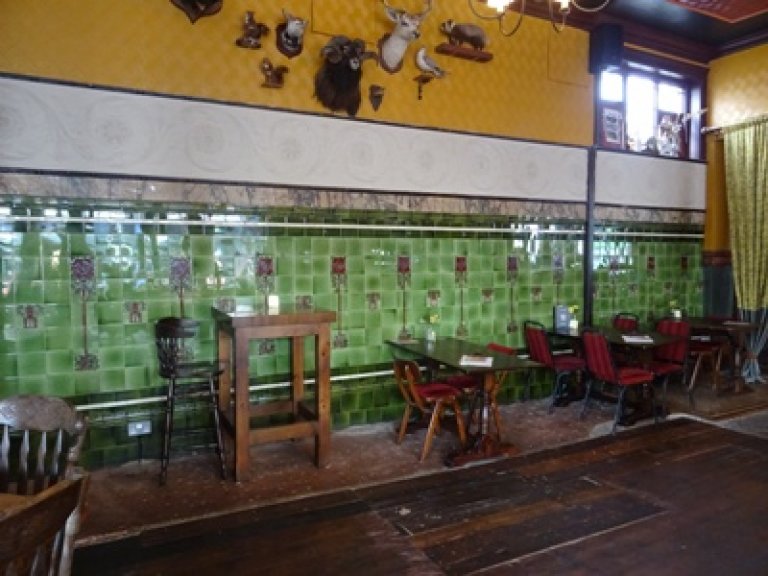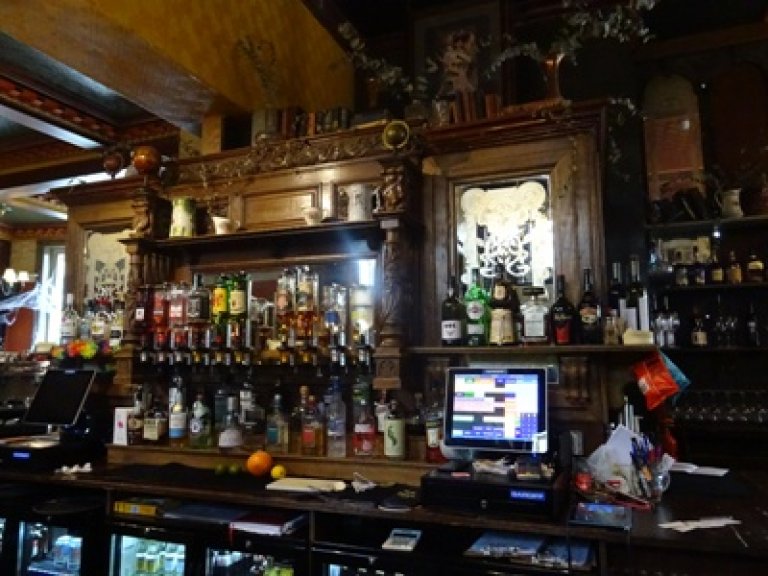Denmark Arms
381 Barking RdEast Ham
E6 1LA
This pub is not only a grade II listed building, it is also a Two Star pub on the Campaign for Real Ale’s (CAMRA) National Inventory with an interior of very special national historic interest, and the description is as follows: “Over the crossroads from the stunning town hall, this is a pub in two parts – a late 19th-century building on the corner by Frederick Ashton (source: Pevsner’s Buildings of England London East, uncorroborated) and a major extension of 1903 along High Street North. The ground floor is now one large room wrapped around the servery (modern back fittings) but what makes it special are the ornate details, notably the lovely tiled frieze on the back wall of the older part of the pub with its plain green tiles and statuesque rose bushes, reminiscent of the Glasgow School. Above is a mottled alabaster band then a decorative frieze with tendrils swirling round stylised rosettes. In the new part (former saloon) the treatment is different with a ceiling divided into bold panels with deep cornices, and a high-level frieze with figures. The columns in the two areas are also different - thin Corinthian ones in the older area, chunky Ionic ones in the newer. If the pub's not too busy do ask to see the upper floor (now a function room). The front part was a restaurant and the back almost certainly a billiard room, and a very spectacular one at that with a fine skylight and a glazed-in servery with hatches. At the foot of the stair is a unique feature for a pub - a ticket booth-style shop for selling cigarettes and drink. This looks interwar as do many of the features of the upper floor. There is a separate, tall entrance with staircase from High Street North. History over the road: East Ham’s (now Newham’s) town hall was built 1901-3 to designs by Cheers & Smith and is particularly notable for its facing of glazed red Accrington bricks.”
The listing description is as follows: “Public House. c.1890, extended to south c.1900. Gault and red brick with sandstone window surrounds and dressings and terracotta plaques; concrete corrugated roof tiles. EXTERIOR: two storeys and dormer attic; six-window range. Earlier wing to north also two storeys and dormer attic. Four bay ground-floor public house front consists of two tripartite leaded windows separated by pilasters below a deep cornice of artificial stone. Arched doorway under segmental pediment with achievement and second door in canted corner bay under segmental head and cornice of artificial stone. First floor of brick banded with artificial stone. Three two-light transomed windows under alternating triangular and segmental pediments with carving. Canted bay window to right through two storeys pierced by single-light casements, arranged as a frieze of five in attic storey. Tall gabled dormer to left of elevation with three-light mullioned window. Canted bay with artificial stone plaque bearing name of premises. Stacks on north and south wall planes. Later build of six window bays east and south, with a canted corner bay to the south-east terminating in a domed attic cupola. Each elevation identical: four composite pilasters to ground floor frame arched windows with leaded glazing. Arched entrance doors to ends of elevations and a principal entrance in south-east corner. Central three window bays project and the first floor divided by sandstone pilasters. One- and two-light casements. Frieze of terracotta relief panels set in cornice. Attic consists of a central gabled dormer with two single-light arched one/one horned sashes and a small round-headed dormer towards ends of elevation fitted with one one/one horned sash. Reduced ridge stack. Late C20 pentice dormer. INTERIOR: north bar with open plan. Two Ionic columns support heavy modillion cornices dividing ceiling into 6 rectangular compartments. Walls with dado rail and deep plaster cornice decorated with putto supporting achievements. Pedimented doorcases to toilets at north end separated by marble chimneypiece with a mirror as overmantel. Similar chimneypiece in south wall at east end. Further pedimented doorcase to exterior to right. Bar counter altered 1970s. South bar designed as public bar and less elaborate. Two thin Corinthian columns rise to plain cornices dividing ceiling into six rectangular compartments. Bar counter altered 1970s but west side retains original Ionic columns. Walls with heavy lincrusta frieze. Main doorways with engraved glass.”
WhatPub link: WhatPub/Denmark Arms
Pub Heritage Group Link: PHG/Denmark Arms
The Denmark Arms featured on the Eastern Delights: Daytime Crawl of East Ham, Plaistow, Isle of Dogs and Limehouse on 26 October 2019, and the Oriental Splendour: Daytime Tour of Dagenham and East Ham on 16 October 2021.





